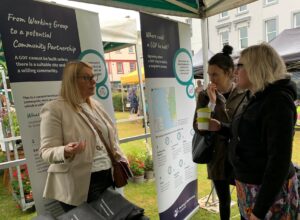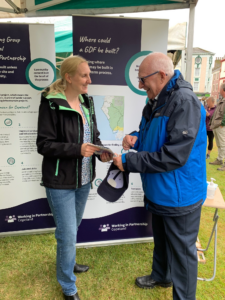Welcome to the August edition of the Copeland GDF Working Group newsletter. We’re looking forward to our public exhibitions starting next week across 10 venues in Copeland. We’ve also been holding some smaller pop-up events over the summer and listening to people’s views – read on for more. Please also see a guest blog from Jason Savage, Shadow Board Chair, Britain’s Energy Coast Business Cluster.
The Working Group has been looking forward to meeting with people to bring you our exhibition for a long time. Next week we will begin our exhibition roadshow in Copeland from Wednesday, September 1 when it starts at The Beacon Portal, in Whitehaven.
So, if you want to know more about geological disposal, how a suitable site for a Geological Disposal Facility (GDF) is identified and what it could mean for Copeland, I’d encourage you to come along.
A GDF, is an underground facility designed to safely and securely dispose of our radioactive waste – specifically ‘higher-activity’ waste. It involves building a series of specially designed and engineered vaults and tunnels deep underground, at a depth of between 200 and 1000 metres. It could potentially be three times deeper than the height of the Shard in London, Britain’s tallest building.
You can also find out more about what a community partnership is, how it’s formed and what it will do, some interesting facts and figures you may not know – as well as subjects including geology, safety and the environment.
We’re asking people to pre-register, to help to ensure we keep within each venue’s capacity and we will also continue to follow Government Covid guidance. See the link further on in the newsletter to choose your preferred date, location and time. Of course, you can turn up on the day, please be aware there may be a wait if capacity has already been reached at that time.
It’s a great opportunity, whether you simply want to look around and find out more, take away some information to read at home, ask questions, share your views, and speak to members of the Copeland GDF Working Group plus experts from Radioactive Waste Management. We look forward to seeing you.
Our Community Engagement Team has been out and about at our pop-up events throughout Copeland over the past six weeks. There’s been plenty to talk about – see more further on in the newsletter – and those conversations are continuing so keep coming to see us and keep giving us your views.
Households in Copeland have also started receiving an information leaflet this month from the Copeland GDF Working Group – with everything you need to get in touch and also the full list of our exhibition dates and times.
As always, the Working Group welcomes any requests for information or talks, views can be shared and questions can be asked by contacting us via email: gdfinfo-copeland@nda.gov.uk telephone 0300 369 0000 or writing to: Copeland GDF Working Group, GDF Enquiries, PO Box 734, Swansea SA1 9RP.

Mark Cullinan Independent Chair Copeland GDF Working Group
Copeland GDF Working Group Exhibition Roadshow
 A GDF is an underground facility designed to safely and securely dispose of higher activity radioactive waste. Copeland GDF Working Group has organised a series of exhibitions to encourage further conversations and understanding about geological disposal.
A GDF is an underground facility designed to safely and securely dispose of higher activity radioactive waste. Copeland GDF Working Group has organised a series of exhibitions to encourage further conversations and understanding about geological disposal.
It will take place across Copeland from September 1-17 and is a chance to hear more, give views, ask questions, raise any concerns and understand potential opportunities. There will be plenty of information plus some interactive content and virtual reality.
Gillian Johnston, Community Engagement Manager for Copeland GDF Working Group, said: “We are looking forward to getting out and about more in our local communities to speak with people face to face.
“Anyone can come along and look around the exhibition, speak to members of the Copeland GDF Working Group and local community engagement team – as well as scientists, geologists and engineers from Radioactive Waste Management (RWM).
“It’s a chance for us to hear more views from you, listen, answer your questions and have further conversations in person.”
The events will operate within current Government guidance and will be held across the following locations and times:
- The Beacon Portal, Whitehaven: Sept 1 (10am-7pm); Sept 2 (9.30am-2pm)
- Silecroft Village Hall: Sept 3 (10am-2pm)
- Kirksanton Village Hall: Sept 3 (5pm-8pm)
- Thwaites Village Hall: Sept 4 (10am-6pm)
- Millom Rugby Union Club, Haverigg: Sept 6 (10am-6pm)
- Drigg & Carleton Village Hall: Sept 7 (10am-6pm)
- Egremont Methodist Church: Sept 8 (10am-6pm); Sept 9 (10am-6pm)
- Cleator Moor Civic Hall: Sept 10 (10am-6pm); Sept 11 (10am-2pm)
- St Bees Management Centre: Sept 13 (10am-6pm); Sept 14 (10am-6pm)
- Whitehaven Golf Club: Sept 16 (10am-7pm); Sept 17 (10am-2pm)
People are invited to register in advance, by going online to book a morning or afternoon visit at their preferred location: Copeland GDF Exhibition – Roadshow (rwmevents.co.uk). This will help to manage each venue’s capacities and ensure Covid-safety. Alternatively, telephone the Copeland Call Centre on 0300 369 0000 to book your place. Those who choose to turn up on the day without registering will be able to enter when there’s a safe space – however there may be a wait if the venue is fully booked at that time.
As part of the process to find a site for a GDF in England or Wales, a Working Group was formed in Copeland last November. It has three main tasks – begin to understand community issues, examine any concerns and questions the public has about a GDF; identify a search area or areas within Copeland and recruit initial members for a Community Partnership which could take that work forward.
Out and about at the Working Group pop-up events
The Working Group’s Community Engagement team has been holding pop-up events in Copeland over the past six weeks about geological disposal and what it could mean for Copeland.

Community Engagement Manager Gillian Johnston talking with people at the Whitehaven Traders’ event.
They’ve taken place in Cleator Moor, Whitehaven, Millom, Seascale, Egremont and Thwaites.
A variety of topics have been discussed during many conversations and have included – the Working Group itself, safety, geology, jobs opportunities, what a Community Partnership entails, what Community Investment Funding is and what it can be used for.
Gillian Johnston, Community Engagement Manager for the Working Group, said:
“It’s been good to finally be able to speak to people face to face after many months of mainly online and telephone conversations. One of our important tasks is to talk to people, offer information and help to answer questions.
“The pop-up events attracted many people who were interested in finding out more, giving views, sharing concerns and asking about opportunities. There’s been a high level of interest from the public and we’ll be continuing to listen and take on board opinions as we move onto our September exhibitions.
“These exhibitions will offer more information and activities to get involved in, as well as having a knowledgeable team from Radioactive Waste Management and members of the Working Group on hand to answer questions.”

Claire Dobson at the Whitehaven Traders event
An example of some of the questions asked during the events were: What does the Working Group do? Will parish councillors be invited to join a Community Partnership? Is it safe to dispose of nuclear waste in rock deep under the seabed? How big would the site be? Isn’t the geology in Copeland not right for GDF? How many jobs would it bring? How long would the jobs be for? When would the Community Investment funding commence and how much is it? Will there be a referendum? What was the reason for the previous consultation being stopped? What will you do with the spoil out of the ground? What about retrievability of the waste? Why isn’t there a world-wide solution to this?
As always if you have a question, please get in touch: gdfinfo-copeland@nda.gov.uk or telephone 0300 369 0000.
We asked Jason Savage, Chair of the Britain’s Energy Coast Business Cluster (BECBC) Shadow Board, to give us his views on what a Geological Disposal Facility (GDF) could mean for Copeland. The Shadow Board is a group of young professionals who have a voice in key decisions with BECBC as well as supporting and driving opportunities in Cumbria.
 “It’s not until you step back and look, that you appreciate the number of conversations, public and yet to be announced, going on in Copeland about possible opportunities which will bring change to the area – and that isn’t by chance.
“It’s not until you step back and look, that you appreciate the number of conversations, public and yet to be announced, going on in Copeland about possible opportunities which will bring change to the area – and that isn’t by chance.
There are groups of people working very hard to showcase Copeland as an attractive place to invest in, not only to benefit local people, but as a benefit to the United Kingdom. This is based on our skills, location and attitude to change.
We are starting to see tangible investment and interest in Copeland such as the opening of the Bus Station and Barclays Eagle Lab in Whitehaven. Conversations around the coal mine, whichever side you sit on, and the potential for a nuclear fusion facility are all indicators of the growing interest in setting up big projects in the borough.
The GDF is one of the crucial conversations we all can get involved in. We need a GDF to deal with nuclear waste for the long term so that future generations don’t have to live with the challenges we are facing today. We can’t make the waste vanish, so we have to manage it safely with as little impact on the environment as possible.
A lot of change is coming in the next few years. It has to, if we are going to achieve Net Zero and strengthen our economy, but it won’t happen in the time we need it to if the conversations are ignored.
It is particularly important that young people are included in the conversations and given the opportunity to ask questions and voice their opinions. The Copeland GDF Working Group offers a breadth of information, not least through this newsletter, to help inform your conversations with colleagues, friends and family.
In our Open to Question slot this month we asked Radioactive Waste Management (RWM) some questions around geological disposal and safety:
Will a GDF be safe for people and the environment?
Yes – safety of a GDF is our number one priority and must be assured by independent regulators. A GDF will not be built unless we, and they, are satisfied it is safe and secure for present and future generations.
We can only build a GDF if we demonstrate to the UK’s independent nuclear and environmental regulators that people and the environment will not be harmed as a result of construction, operation and in the long-term, following closure. We demonstrate this by presenting our scientific, technical and management evidence in a safety case. A GDF uses a multi-barrier approach to containment and there is confidence that the stable geology provides a barrier in the very long term.
How do you approach safety?
We will have to demonstrate to the nuclear and environmental regulators that the GDF will be safe and secure before they will allow us to start construction. We will do this by presenting evidence in a safety case. RWM would also need to obtain a nuclear site licence and environmental permit, which means a GDF would be subject to same requirements for safety as any other nuclear site. We meet regularly with the regulators to understand and address their requirements.
What research has been done to reassure the public of its safety?
Research has demonstrated that enough is known about geological disposal to proceed with confidence. There has been more than 30 years of research worldwide into the technical feasibility, scientific implications and safety requirements of geological disposal. This research is published and openly available and has been extensively peer reviewed. You can find our safety reports on www.gov.uk/rwm
How does the rock provide safety?
The natural geological barrier isolates the waste from the surface and helps to contain the radioactivity. It works together with engineered barriers as part of a multiple barrier system to prevent hazardous levels of radioactivity from ever reaching the surface environment.
Different rock types have different properties, and so the engineered barriers will be designed to complement the substantial natural barrier provided by depth and type of rock above, around and within the underground facility.

